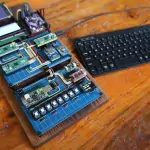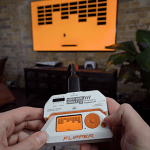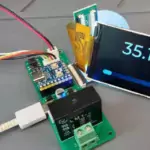If when you think of a synth your mind automatically goes to electronic music, prepare to have your aurally-biased brain blown. This is a video synth that flips through glitchy, retro animations, and it’s built around RP2040.
Nice Liz Clarke, whom you may know better as Blitz City, is responsible for this nifty synth. If people were still monitoring vibe checks, she would most definitely pass.
Parts list
- Adafruit Feather RP2040 (built on our RP2040 chip)
- 7″ display
- FeatherWing Proto
- FeatherWing Doubler
- Four potentiometers with clear knobs
- A couple of nice illuminated push buttons

Laser-cut acrylic provides the gorgeous enclosure for the electronics. Everything is mounted on one of just two transparent plates, letting the hardware shine. If you’d rather 3D print one, you can grab the .STL files here.
How does it work?
The Feather RP2040 and a FeatherWing Proto sit next to each on the FeatherWing Doubler. The potentiometers and buttons are wired via the FeatherWing Proto. This nice show-and-tell will help you do the wiring. The Feather RP2040 powers everything via its USB port and runs Arduino code from the PicoDVI library. All the project code is up for grabs here.
There are five animations coded onto the video synth. Twiddle the potentiometer knobs to alter each animation like a visual DJ. Three of them adjust the colours, and one changes different visual aspects depending on which animation is playing.
Shebang
The blue button is a special “shebang” button. I thought “shebang” was just Adafruit being Adafruit in their nomenclature, but I followed their hyperlinked rabbit hole to discover that a shebang is actually the name for this very recognisable string: #!
Raspberry Pi and Commodore 64 Synthesiser
I can’t let a synth project go by without shouting out one of my favourite ever projects made by one of our engineers. Simon Martin had wanted to make his own electronic musical instrument with Raspberry Pi for some time. He had designed a circuit board for the project a long time ago, but it had been lying around in a drawer while he finished work on Raspberry Pi 400. Finally, the winter months of lockdown gave him the incentive to get it working, and he created a Raspberry Pi and Commodore 64 Synthesiser.








